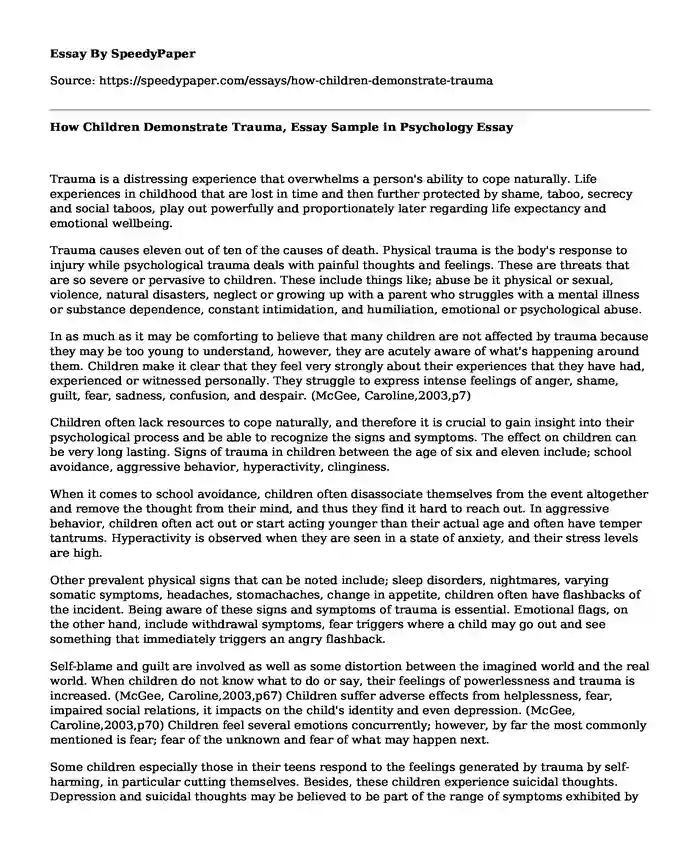
| Type of paper: | Essay |
| Categories: | Psychology Child development Post traumatic stress disorder |
| Pages: | 3 |
| Wordcount: | 758 words |
Trauma is a distressing experience that overwhelms a person's ability to cope naturally. Life experiences in childhood that are lost in time and then further protected by shame, taboo, secrecy and social taboos, play out powerfully and proportionately later regarding life expectancy and emotional wellbeing.
Trauma causes eleven out of ten of the causes of death. Physical trauma is the body's response to injury while psychological trauma deals with painful thoughts and feelings. These are threats that are so severe or pervasive to children. These include things like; abuse be it physical or sexual, violence, natural disasters, neglect or growing up with a parent who struggles with a mental illness or substance dependence, constant intimidation, and humiliation, emotional or psychological abuse.
In as much as it may be comforting to believe that many children are not affected by trauma because they may be too young to understand, however, they are acutely aware of what's happening around them. Children make it clear that they feel very strongly about their experiences that they have had, experienced or witnessed personally. They struggle to express intense feelings of anger, shame, guilt, fear, sadness, confusion, and despair. (McGee, Caroline,2003,p7)
Children often lack resources to cope naturally, and therefore it is crucial to gain insight into their psychological process and be able to recognize the signs and symptoms. The effect on children can be very long lasting. Signs of trauma in children between the age of six and eleven include; school avoidance, aggressive behavior, hyperactivity, clinginess.
When it comes to school avoidance, children often disassociate themselves from the event altogether and remove the thought from their mind, and thus they find it hard to reach out. In aggressive behavior, children often act out or start acting younger than their actual age and often have temper tantrums. Hyperactivity is observed when they are seen in a state of anxiety, and their stress levels are high.
Other prevalent physical signs that can be noted include; sleep disorders, nightmares, varying somatic symptoms, headaches, stomachaches, change in appetite, children often have flashbacks of the incident. Being aware of these signs and symptoms of trauma is essential. Emotional flags, on the other hand, include withdrawal symptoms, fear triggers where a child may go out and see something that immediately triggers an angry flashback.
Self-blame and guilt are involved as well as some distortion between the imagined world and the real world. When children do not know what to do or say, their feelings of powerlessness and trauma is increased. (McGee, Caroline,2003,p67) Children suffer adverse effects from helplessness, fear, impaired social relations, it impacts on the child's identity and even depression. (McGee, Caroline,2003,p70) Children feel several emotions concurrently; however, by far the most commonly mentioned is fear; fear of the unknown and fear of what may happen next.
Some children especially those in their teens respond to the feelings generated by trauma by self-harming, in particular cutting themselves. Besides, these children experience suicidal thoughts. Depression and suicidal thoughts may be believed to be part of the range of symptoms exhibited by teenagers and adolescents who have specifically witnessed violence. (McGee, Caroline,2003,p75)
The emotional effects of childhood trauma are known but new studies, however, show that the child's positive as well as negative experiences can shape and reshape the brain. Children demonstrate shock either through fear and anxiety. Fewer neuro connections are made that involve reasoning, planning and behavioral control.
Such feelings inevitable affect their self-esteem, their education, their behavior and their ability to make friends and have relationships with others. (McGee, Caroline,2003,p7) The primary question to pose in this research is how society can help children deal with trauma inflicted by their experiences. Most children believe they can stay protected by not discussing how they have suffered. In such circumstances, children worry about saying anything that will bring back the emotional burden.
One of the main predictors of a child's ability to be resilient in the face of trauma is interacting with an adult who is caring and loving. Some intervention tips that could be looked into are; active listening; this involves being involved with the child and their well being, answer any questions that the children have since they are very curious. Other things include; encouraging them through verbal, written and artistic expressions. Through these everyday gestures, you can help a child look forward towards a bright future.
References
Ahma. (2011, December 8). Signs of Trauma in Chidren. https://www.youtube.com/watch?v=O9ToxST01&objreload=10.
McGee, C. (2003). Childhood experince of Domestic Violence. 7-76.
Cite this page
How Children Demonstrate Trauma, Essay Sample in Psychology. (2022, Mar 02). Retrieved from https://speedypaper.net/essays/how-children-demonstrate-trauma
Request Removal
If you are the original author of this essay and no longer wish to have it published on the SpeedyPaper website, please click below to request its removal:
- Bullying Essay Example for You to Take Advantage Of
- Free Essay on Advantages and Disadvantages of Technology
- Apple Project Management Essay Sample
- The Dangers of Procrastination from Landscape by Louise Gluck, Poem Analysis Essay Sample
- Education Essay Example: Urban Design and City Planning MSc
- Free Essay with an Economic Analysis of Inflation and Unemployment
- Essay Sample on WLAN and Mobile Security Plan
Popular categories




